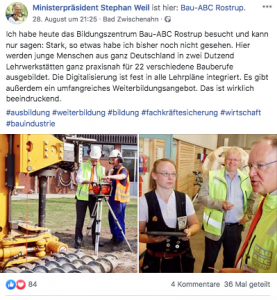A German top politician visits Bau-ABC Rostrup – Great praise for the training of apprentices
Earlier this week Ministerpräsident Stephan Weil (prime minister of the Federal State of Lower Saxony) made a field visit to the North-German training centre Bau-ABC Rostrup. As the readers of this blog know, Bau-ABC played a vital role in our EU-funded project Learning Layers (2012-2016) as the main application partner of the Construction pilot of the said project. During the project researchers, technical partners and trainers of Bau-ABC worked together to develop an integrative toolset – the Learning Toolbox (LTB) to support vocational and workplace-based learning. Now, some time after the end of the project, it was interesting to see, how the prime minister perceived the training and learning that was presented to him. Let us start with prime minister Weil’s comment on his Facebook page and then give more information on the visit.
Prime minister Weil on the training and learning at Bau-ABC Rostrup
On his Facebook page prime minister Weil published the following, highly inspired update (see below). And another picture shows that he was involved in hands-on training during the field visit (see below).
The comment that prime minister Weil made in his Facebook-update above was the following (translated into English by me):
“Today I have visited the training centre Bau-ABC Rostrup and I can only say the following: They have a strong case – I have not seen anything similar before. They are training young people from all over Germany in two dozen training workshops and in very practical way to master 22 different construction trades, Digitization is solidly integrated in all curricula. And on top oft hat they have a broad-based provision of continuing training schemes. This is really impressive.”
And as we can see from the pictures, he took time to inform himself by trainers, apprentices and managers. And he also egaged himself in discussions and in hands-on training.
Reporting on the field visit in a journal article
The field visit was covered by the article of Christian Qapp “Ein Ministerpräsident als Azubi” published in NWZ Online. The article made the point that the prime minister took the role of apprentice (guided by an experienced apprentice) on the drilling grounds. And at different training sites the apprentices had a major role in presenting the training in their trades.
From the perspective of promoting digital competences in vocational education and training (VET) the article makes an interesting point (translated into English by me):
“The apprentices in carpentry, Vanessa Hermes, and in pipeline-building, Linus Köneking, explained the Learning Toolbox. The App for Smartphones and Tablet-PCs was developed in collaboration with Bau-ABC. Now it is being used there from the very first day of apprentice training on. On the one hand it contains practical information for apprentices on travel arrangements, Accommodation and on the daily menu of the canteen. But equally it presents learning tasks with three-dimensional models, digital measurements and with creating lists of necessary construction materials. With all this the apprentices can deal with by taking the gadget from their pocket. And, moreover, they themselves can document their own work with the help of the app.”
Reflective commentary
For us, who had been involved in the project work that led to the development of the Learning Toolbox, it is very rewarding to hear such comments from a top politician and to read such news reports. They deliver to us the message that the use of the digital toolset Learning Toolbox has become lived practice. Moreover, it is clear that the apprentices are in the best position to tell, how thwy can benefit from using it. We are happy to follow the progress of Bau-ABC Rostrup and others who are working with the Learning Toolbox. It is very inspiring to learn more from the users.
More blogs to come …


